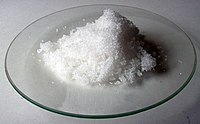Sodium Nitrate
 |
|||
|
|
|||
| Names | |||
|---|---|---|---|
|
IUPAC name
Sodium nitrate
|
|||
| Other names
Peru saltpeter Soda niter cubic niter |
|||
| Identifiers | |||
|
7631-99-4 |
|||
| 3D model (Jmol) | Interactive image | ||
| ChEMBL |
ChEMBL1644698 |
||
| ChemSpider |
22688 |
||
| ECHA InfoCard | 100.028.686 | ||
| EC Number | 231-554-3 | ||
| E number | E251 (preservatives) | ||
| PubChem | 24268 | ||
| RTECS number | WC5600000 | ||
| UNII |
8M4L3H2ZVZ |
||
| UN number | 1498 | ||
|
|||
|
|||
| Properties | |||
| NaNO3 | |||
| Molar mass | 84.9947 g/mol | ||
| Appearance | White powder or colorless crystals | ||
| Odor | sweet | ||
| Density | 2.257 g/cm3, solid | ||
| Melting point | 308 °C (586 °F; 581 K) | ||
| Boiling point | 380 °C (716 °F; 653 K) decomposes | ||
| 73 g/100 mL (0 °C) 91.2 g/100 mL (25 °C) 180 g/100 mL (100 °C) |
|||
| Solubility | very soluble in ammonia, hydrazine soluble in alcohol slightly soluble in pyridine insoluble in acetone |
||
| −25.6·10−6 cm3/mol | |||
|
Refractive index (nD)
|
1.587 (trigonal) 1.336 (rhombohedral) |
||
| Viscosity | 2.85 cP (317 °C) | ||
| Structure | |||
| trigonal and rhombohedral | |||
| Thermochemistry | |||
| 93.05 J/(mol K) | |||
|
Std molar
entropy (S |
116 J/(mol K) | ||
|
Std enthalpy of
formation (ΔfH |
−467 kJ/mol | ||
|
Gibbs free energy (ΔfG˚)
|
−365.9 kJ/mol | ||
| Hazards | |||
| Main hazards | Oxidant, irritant | ||
| Safety data sheet | ICSC 0185 | ||
|
EU classification (DSD)
|
|||
| NFPA 704 | |||
| Flash point | Non-flammable | ||
| Lethal dose or concentration (LD, LC): | |||
|
LD50 (median dose)
|
3236 mg/kg | ||
| Related compounds | |||
|
Other anions
|
Sodium nitrite | ||
|
Other cations
|
Lithium nitrate Potassium nitrate Rubidium nitrate Caesium nitrate |
||
|
Related compounds
|
Sodium sulfate Sodium chloride |
||
|
Except where otherwise noted, data are given for materials in their standard state (at 25 °C [77 °F], 100 kPa).
|
|||
|
|
|||
| Infobox references | |||
Sodium nitrate is the chemical compound with the formula NaNO3. This alkali metal nitrate salt is also known as Peru saltpeter (due to the large deposits found in the Atacama desert in these countries) to distinguish it from ordinary saltpeter, potassium nitrate. The mineral form is also known as nitratine, nitratite or soda niter.
Sodium nitrate is a white solid very soluble in water. It is a readily available source of the nitrate anion (NO3−), which is useful in several reactions carried out on industrial scales for the production of fertilizers, pyrotechnics and smoke bombs, glass and pottery enamels, food preservatives (esp. meats), and solid rocket propellant. It has been mined extensively for these purposes.
The first shipment of Peruvian saltpeter to Europe arrived in England in 1820 or 1825, right after that country's independence from Spain, but did not find any buyers and was dumped at sea in order to avoid customs toll. With time, however, the mining of South American saltpeter became a profitable business (in 1859, England alone consumed 47,000 metric tons). Chile fought against the allies Peru and Bolivia in the War of the Pacific 1879-1884 and took over their richest deposits. In 1919, Ralph Walter Graystone Wyckoff determined its crystal structure using X-ray crystallography.
...
Wikipedia



